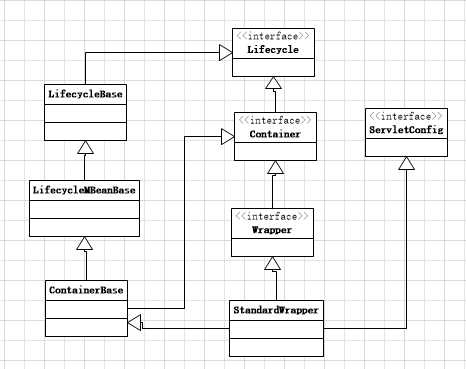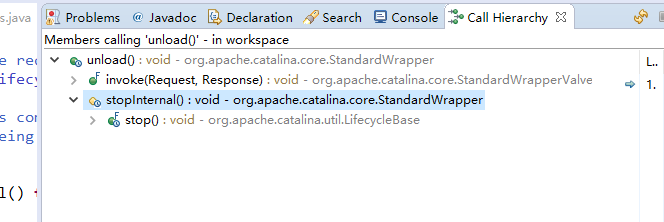这篇分析另一个人容器Wrapper,这个跟之前分析的Server、Service、Host、Engine 和Context不同,前面分析的容器可以直接在Server.xml配置,Context可以配置也可不配置,但是Wrapper是在容器初始化过程中创建的。主要是在第十三章中分析WebConfig方法的第九步configureContext里面创建的,下图是Wrapper的继承关系

下面是创建Wrapper的代码片段
private void configureContext(WebXml webxml) {
……………………….
for (ServletDef servlet : webxml.getServlets().values()) {
//调用StandardContext对象createWrapper方法创建StandardWrapper对象,给对象添加LifecyecleListener和ContainerListener
Wrapper wrapper = context.createWrapper();
//下面一系列的set都是将servlet的配置设置给Wrapper,由此可见Wrapper就是对Servelt的一个包装(decorator设计模式)
if (servlet.getLoadOnStartup() != null) {
wrapper.setLoadOnStartup(servlet.getLoadOnStartup().intValue());
}
if (servlet.getEnabled() != null) {
wrapper.setEnabled(servlet.getEnabled().booleanValue());
}
wrapper.setName(servlet.getServletName());
Map<String,String> params = servlet.getParameterMap();
for (Entry<String, String> entry : params.entrySet()) {
wrapper.addInitParameter(entry.getKey(), entry.getValue());
}
wrapper.setRunAs(servlet.getRunAs());
Set<SecurityRoleRef> roleRefs = servlet.getSecurityRoleRefs();
for (SecurityRoleRef roleRef : roleRefs) {
wrapper.addSecurityReference(
roleRef.getName(), roleRef.getLink());
}
wrapper.setServletClass(servlet.getServletClass());
MultipartDef multipartdef = servlet.getMultipartDef();
if (multipartdef != null) {
if (multipartdef.getMaxFileSize() != null &&
multipartdef.getMaxRequestSize()!= null &&
multipartdef.getFileSizeThreshold() != null) {
wrapper.setMultipartConfigElement(new MultipartConfigElement(
multipartdef.getLocation(),
Long.parseLong(multipartdef.getMaxFileSize()),
Long.parseLong(multipartdef.getMaxRequestSize()),
Integer.parseInt(
multipartdef.getFileSizeThreshold())));
} else {
wrapper.setMultipartConfigElement(new MultipartConfigElement(
multipartdef.getLocation()));
}
}
if (servlet.getAsyncSupported() != null) {
wrapper.setAsyncSupported(
servlet.getAsyncSupported().booleanValue());
}
wrapper.setOverridable(servlet.isOverridable());
//add的同时会start Wrapper
context.addChild(wrapper);
}
for (Entry<String, String> entry :
webxml.getServletMappings().entrySet()) {
//StandardContext添加与Servlet对应的ServletMapping
context.addServletMappingDecoded(entry.getKey(), entry.getValue());
}
……………………………..
}
现在来看StandardWrapper类,首先是它的构造方法,创建Valve,处理http请求的时候起作用,后面分析
public StandardWrapper() {
super();
swValve=new StandardWrapperValve();
pipeline.setBasic(swValve);
broadcaster = new NotificationBroadcasterSupport();
}
还有几个重要的方法,allocate、load、unload
先看下load方法的调用链

StandardContext startInternal方法触发ContextConfig的Config_Start(Wrapper是在webConfig方法step9创建)方法后,调用loadOnStartup 从而调用到Wrapper的load方法,下面是StartInternal的代码片段
fireLifecycleEvent(Lifecycle.CONFIGURE_START_EVENT, null);
………………….
if (ok) {
if (!loadOnStartup(findChildren())){
log.error(sm.getString("standardContext.servletFail"));
ok = false;
}
}
Load方法代码
public synchronized void load() throws ServletException {
//goto 分析loadServlet方法
instance = loadServlet();
if (!instanceInitialized) {
//没有实例化这个servlet就调用initServlet
//goto分析initServlet方法
initServlet(instance);
}
if (isJspServlet) {
//如果是jspservlet,则把这个servlet作为MBean
StringBuilder oname = new StringBuilder(getDomain());
oname.append(":type=JspMonitor");
oname.append(getWebModuleKeyProperties());
oname.append(",name=");
oname.append(getName());
oname.append(getJ2EEKeyProperties());
try {
jspMonitorON = new ObjectName(oname.toString());
Registry.getRegistry(null, null)
.registerComponent(instance, jspMonitorON, null);
} catch( Exception ex ) {
log.info("Error registering JSP monitoring with jmx " +
instance);
}
}
}
分析loadServlet方法:
public synchronized Servlet loadServlet() throws ServletException {
if (!singleThreadModel && (instance != null))
return instance;
PrintStream out = System.out;
if (swallowOutput) {
SystemLogHandler.startCapture();
}
Servlet servlet;
try {
long t1=System.currentTimeMillis();
if (servletClass == null) {
unavailable(null);
throw new ServletException
(sm.getString("standardWrapper.notClass", getName()));
}
// InstanceManager默认是DefaultInstanceManager,StandardContext创建DefaultInstanceManager后,会用Webapploader的classloader binding
InstanceManager instanceManager = ((StandardContext)getParent()).getInstanceManager();
try {
//用instanceManager实例化Servlet,每个StandardContext都会创建InstanceManager,每个instanceManager会合每个webapploader的classloader绑定
//不同的Context的servlet会用不同的classloader加载
servlet = (Servlet) instanceManager.newInstance(servletClass);
} catch (ClassCastException e) {
unavailable(null);
throw new ServletException
(sm.getString("standardWrapper.notServlet", servletClass), e);
} catch (Throwable e) {
e = ExceptionUtils.unwrapInvocationTargetException(e);
ExceptionUtils.handleThrowable(e);
unavailable(null);
// Added extra log statement for Bugzilla 36630:
// http://bz.apache.org/bugzilla/show_bug.cgi?id=36630
if(log.isDebugEnabled()) {
log.debug(sm.getString("standardWrapper.instantiate", servletClass), e);
}
// Restore the context ClassLoader
throw new ServletException
(sm.getString("standardWrapper.instantiate", servletClass), e);
}
if (multipartConfigElement == null) {
//实例化MultipartConfigElement,解析MultipartConfig注解,跟文件上传有关
MultipartConfig annotation = servlet.getClass().getAnnotation(MultipartConfig.class);
if (annotation != null) {
multipartConfigElement =
new MultipartConfigElement(annotation);
}
}
//处理ServletSecurity 注解,调用Context addServletSecurity
processServletSecurityAnnotation(servlet.getClass());
//判断这个servlet是不是 ContainerServlet(类全名有org.apache.catalina.或者继承ContainerServlet)
if ((servlet instanceof ContainerServlet) &&
(isContainerProvidedServlet(servletClass) ||((Context) getParent()).getPrivileged() )) {
((ContainerServlet)servlet).setWrapper(this);
}
classLoadTime=(int) (System.currentTimeMillis() -t1);
if (servlet instanceof SingleThreadModel) {
if (instancePool == null) {
//实例化instancePool
instancePool = new Stack<>();
}
singleThreadModel = true;
}
//调用Servlet的init方法,参数是ServletConfig
initServlet(servlet);
fireContainerEvent("load", this);
loadTime=System.currentTimeMillis() -t1;
} finally {
if (swallowOutput) {
String log = SystemLogHandler.stopCapture();
if (log != null && log.length() > 0) {
if (getServletContext() != null) {
getServletContext().log(log);
} else {
out.println(log);
}
}
}
}
return servlet;
}
Unload方法:主要逻辑调用servlet的destroy方法
下图是unload方法的调用链

Allocate方法:这个跟请求处理相关,后面分析,现在只看下调用链

本來打算用的新的一篇讲StandardContext的XXXInternal方法,但是浏览源码发现都是对Context所用类(比如Manager等)的创建和释放,主要跟程序相关的配置逻辑还是
在ContextConfig中,Context使用的那些类主要是在处理请求的时候起作用,到时候再分析。
下篇开始,就要分析跟处理请求相关的逻辑了,涉及到tomcat的另一大部分Connector,从Service那里,先分析的Engine这条线(tomcat内部逻辑),现在要分析Connector相关,
因为他跟请求处理相关,还有各个容器的相对应的Valve类,也是跟请求处理相关,下篇开始我们分析Connector相关内容。
版权声明:本文不是「本站」原创文章,版权归原作者所有 | 原文地址: